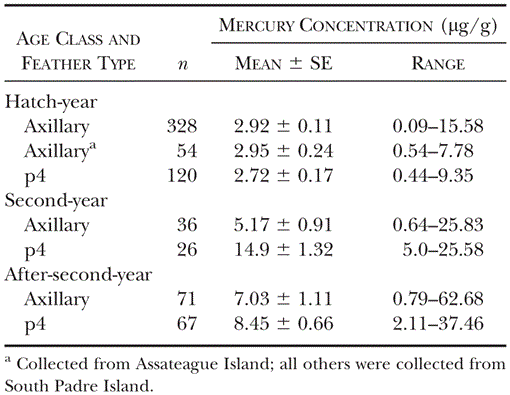Scientists warn peregrine falcons could be the 'canary in the coal mine' for mercury contamination
http://www.brinkwire.com/science/scientists-warn-peregrine-falcons-could-be-the-canary-in-the-coal-mine-for-mercury-contamination/Study Finds Mercury in Predator Peregrine Falcons
https://www.theepochtimes.com/study-finds-mercury-in-predator-peregrine-falcons_2888987.htmlPeregrine falcons from both coasts found contaminated with mercury
https://www.earth.com/news/peregrine-falcons-mercury/Biologist study finds mercury in predator peregrine falcons
https://abcnews.go.com/Technology/wireStory/biologist-study-finds-mercury-predator-peregrine-falcons-62537911Paper: A Broadscale Assessment of Mercury Contamination in Peregrine Falcons Across the Northern Latitudes of North America
https://bioone.org/journals/journal-of-raptor-research/volume-53/issue-1/JRR-18-0003/A-Broadscale-Assessment-of-Mercury-Contamination-in-Peregrine-Falcons-Across/10.3356/JRR-18-0003.full

These prior studies, as well as satellite tracking results (Fuller et al. 1998, McGrady et al. 2002), all indicate that the majority of peregrines encountered at our two study sites originate from Arctic and boreal natal and breeding areas, so we sought to use feathers collected from migrating peregrines in autumn at SPI and AI to inform us remotely of contemporary Hg exposure at northern latitudes during the breeding season (i.e., the time and place where feathers were grown). We initially drew from archived axillary feathers collected in 2009 from the two study sites, and then also sampled fourth primary flight feathers (p4) from 2013?2015 in an effort to refine our knowledge of spatial and temporal Hg concentrations. Additional objectives were to assess differences in Hg exposure by age class and sex, compare Hg concentrations between feather types, and look for changes in Hg levels over time.

In an analysis of the overall variation in mean THg concentrations by feather type and age class, a mixed effects ANOVA model of females sampled at SPI in 2013 indicated significant differences by age class (F1,3 = 1197.1, P= <0.001), feather type (F= 65.7, P= <0.001), and the interaction between age class and feather type (F1,3 = 28.0, P = <0.001; Fig. 2). Our model indicated THg concentrations in p4 feathers were significantly greater than those in axillaries in each age class except HY (Fig. 2). All other age classes contained greater concentrations of THg in p4 feathers than HY females in our model, with SY individuals exceeding all others except AHY individuals (those that were not distinguished between SY and ASY age classes; Fig. 2).

 Author
Topic: New developments in the field of science (Read 754655 times)
Author
Topic: New developments in the field of science (Read 754655 times)
